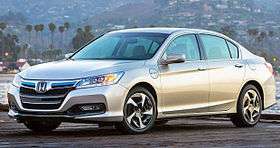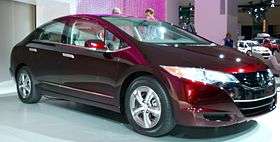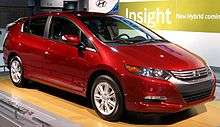Green vehicle
_front_trimmed.jpg)
| Part of a series about |
| Sustainable energy |
|---|
 |
| Energy conservation |
| Renewable energy |
| Sustainable transport |
|
A green vehicle, or clean vehicle, or eco-friendly vehicle or environmentally-friendly vehicle is a road motor vehicle that produces less harmful impacts to the environment than comparable conventional internal combustion engine vehicles running on gasoline or diesel, or one that uses certain alternative fuels.[3][4][5] Presently, in some countries the term is used for any vehicle complying or surpassing the more stringent European emission standards (such as Euro6), or California's zero emissions vehicle standards (such as ZEV, ULEV, SULEV, PZEV), or the low-carbon fuel standards enacted in several countries.[6]
Green vehicles can be powered by alternative fuels and advanced vehicle technologies and include hybrid electric vehicles, plug-in hybrid electric vehicles, battery electric vehicles, compressed-air vehicles, hydrogen and fuel-cell vehicles, neat ethanol vehicles, flexible-fuel vehicles, natural gas vehicles, clean diesel vehicles, and some sources also include vehicles using blends of biodiesel and ethanol fuel or gasohol.[4][7] In November 2016, with an EPA-rated fuel economy of 136 miles per gallon gasoline equivalent (mpg-e) (1.7 L/100 km), the 2017 Hyundai Ioniq Electric became the most efficient EPA-certified vehicle considering all fuels and of all years, surpassing the 2014-2016 model year all-electric BMW i3.[8][9]
Several author also include conventional motor vehicles with high fuel economy, as they consider that increasing fuel economy is the most cost-effective way to improve energy efficiency and reduce carbon emissions in the transport sector in the short run.[10] As part of their contribution to sustainable transport, these vehicles reduce air pollution and greenhouse gas emissions, and contribute to energy independence by reducing oil imports.[4][10]
An environmental analysis extends beyond just the operating efficiency and emissions. A life-cycle assessment involves production and post-use considerations. A cradle-to-cradle design is more important than a focus on a single factor such as energy efficiency.[11][12]
Energy efficiency
Cars with similar production of energy costs can obtain, during the life of the car (operational phase), large reductions in energy costs through several measures:
- The most significant is by using alternative propulsion:
- An efficient engine that reduces the vehicle's consumption of petroleum (i.e. petroleum electric hybrid vehicle), or that uses renewable energy sources throughout its working life.
- Using biofuels instead of petroleum fuels.
- Proper maintenance of a vehicle such as engine tune-ups, oil changes, and maintaining proper tire pressure can also help.
- Removing unnecessary items from a vehicle reduces weight and improves fuel economy as well.
| Comparison of several types of green car basic characteristics (Values are overall for vehicles in current production and may differ between types) | |||||
|---|---|---|---|---|---|
| Type of vehicle/ powertrain | Fuel economy (mpg equivalent) | Range | Production cost for given range | Reduction in CO2 compared to conventional | Payback period |
| Conventional ICE | 10-78 | Long (400-600 mi) | Low | 0% | - |
| Biodiesel | 18-71 | Long (360-540 mi) | Low | 100% | - |
| All-electric | 54-118 | Shorter (73-150 mi) Luxury models Medium (160-300 mi) | High Very high | varies depending on energy source | - |
| Hydrogen fuel cell | 80[13] | Astronomical | |||
| Hybrid electric | 30-60 | 380 mi[13] | Medium | 5 years[14][15] | |
Types
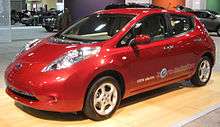
Green vehicles include vehicles types that function fully or partly on alternative energy sources other than fossil fuel or less carbon intensive than gasoline or diesel.
Another option is the use of alternative fuel composition in conventional fossil fuel-based vehicles, making them function partially on renewable energy sources. Other approaches include personal rapid transit, a public transportation concept that offers automated, on-demand, non-stop transportation on a network of specially built guideways.
Electric and fuel cell-powered
Examples of vehicles with reduced petroleum consumption include electric cars, plug-in hybrids and fuel cell-powered hydrogen cars.
Electric cars are typically more efficient than fuel cell-powered vehicles on a Tank-to-wheel basis.[16] For this reason, battery powered vehicles and plug-in hybrids are gaining popularity. They have better fuel economy than conventional internal combustion engine vehicles but are hampered by range or maximum distance attainable before discharging the battery. The electric car batteries are their main cost. They provide a 0%[17] to 99.9% reduction in CO2 emissions compared to an ICE (gasoline, diesel) vehicle, depending on the source of electricity.[18]
Hybrid electric vehicles
Hybrid cars may be partly fossil fuel (or biofuel) powered and partly electric or hydrogen-powered. Most combine an internal combustion engine with an electric engine, though other variations too exist. The internal combustion engine is often either a gasoline or Diesel engine (in rare cases a Stirling engine may even be used[19]). They are more expensive to purchase but cost redemption is achieved in a period of about 5 years due to better fuel economy.[14][15]
Compressed air cars, stirling vehicles, and others
Compressed air cars, stirling-powered vehicles, Liquid nitrogen vehicles are even less polluting than electrical vehicles, as the vehicle and its components can be made more environmentally friendly.
Solar car races are held on a regular basis in order to promote green vehicles and other "green technology". These sleek driver-only vehicles can travel long distances at highway speeds using only the electricity generated instantaneously from the sun.
Improving conventional cars
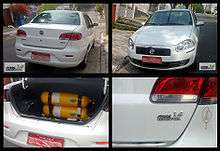
A conventional vehicle can become a greener vehicle by mixing in renewable fuels or using less carbon intensive fossil fuel. Typical gasoline-powered cars can tolerate up to 10% ethanol. Brazil manufactured cars that run on neat ethanol, though there were discontinued. Another available option is a flexible-fuel vehicle which allows any blend of gasoline and ethanol, up to 85% in North America and Europe, and up to 100% in Brazil.[20] Another existing option is to convert a conventional gasoline-powered to allow the alternative use of CNG. Pakistan, Argentina, Brazil, Iran, India, Italy, and China have the largest fleets of natural gas vehicles in the world.[21]
Diesel-powered vehicles can often transition completely to biodiesel, though the fuel is a very strong solvent, which can occasionally damage rubber seals in vehicles built before 1994. More commonly, however, biodiesel causes problems simply because it removes all of the built-up residue in an engine, clogging filters, unless care is taken when switching from dirty fossil-fuel derived diesel to bio-diesel. It is very effective at 'de-coking' the diesel engines combustion chambers and keeping them clean. Biodiesel is the lowest emission fuel available for diesel engines. Diesel engines are the most efficient car internal combustion engines. Biodiesel is the only fuel allowed in some North American national parks because spillages will completely bio-degrade within 21 days. Biodiesel and vegetable oil fuelled, diesel engined vehicles have been declared amongst the greenest in the US Tour de Sol competition.
This presents problems, as biofuels can use food resources in order to provide mechanical energy for vehicles. Many experts point to this as a reason for growing food prices, particularly US Bio-ethanol fuel production which has affected maize prices. In order to have a low environmental impact, biofuels should be made only from waste products, or from new sources like algae.
Electric Motor and Pedal Powered Vehicles
Multiple companies are offering and developing two, three, and four wheel vehicles combining the characteristics of a bicycle with electric motors. US Federal, State and Local laws do not clearly nor consistently classify [22] these vehicles as bicycles, electric bicycles, motorcycles, electric motorcycles, mopeds, Neighborhood Electric Vehicle, motorised quadricycle or as a car. Some laws have limits on top speeds, power of the motors, range, etc. while others do not.[23][24][25][26]
Other
- Public transportation vehicles are not usually included in the green vehicle category, but Personal rapid transit (PRT) vehicles probably should be. All vehicles that are powered from the track have the advantage of potentially being able to use any source of electric energy, including sustainable ones, rather than requiring liquid fuels. They can also switch regenerative braking energy between vehicles and the electric grid rather than requiring energy storage on the vehicles. Also, they can potentially use the entire track area for solar collectors, not just the vehicle surface. The potential PRT energy efficiency is much higher than that which traditional automobiles can attain.
- Solar vehicles are electric vehicles powered by solar energy obtained from solar panels on the surface (generally, the roof) of the vehicle. Photovoltaic (PV) cells convert the Sun's energy directly into electrical energy. Solar vehicles are not practical day-to-day transportation devices at present, but are primarily demonstration vehicles and engineering exercises, often sponsored by government agencies. However, some cities have begun offering solar-powered buses, including the Tindo in Adelaide, Australia.
- Wind-powered electric vehicles primarily use wind-turbines installed at a strategic point of the vehicle, which are then converted into electric energy which causes the vehicle to propel.
Animal powered vehicles
Horse and carriage are just one type of animal propelled vehicle. Once a common form of transportation, they became far less common as cities grew and automobiles took their place. In dense cities, the waste produced by large numbers of transportation animals was a significant health problem. Oftentimes the food is produced for them using diesel powered tractors, and thus there is some environmental impact as a result of their use.
Human powered vehicles
Human powered transport includes walking, bicycles, velomobiles, row boats, and other environmentally friendly ways of getting around. In addition to the health benefits of the exercise provided, they are far more environmentally friendly than most other options. The only downside is the speed limitations, and how far one can travel before getting exhausted.
Benefits of green vehicle use
Environmental
Vehicle emissions contribute to the increasing concentration of gases linked to climate change.[27] In order of significance, the principal greenhouse gases associated with road transport are carbon dioxide (CO2), methane (CH4) and nitrous oxide (N2O).[28] Road transport is the third largest source of greenhouse gases emitted in the UK, and accounts for over 20% of total emissions,[29] and 33% in the United States.[30] Of the total greenhouse gas emissions from transport, over 85% are due to CO2 emissions from road vehicles. The transport sector is the fastest growing source of greenhouse gases.[31]
Health
Vehicle pollutants have been linked to human ill health including the incidence of respiratory and cardiopulmonary disease and lung cancer. A 1998 report estimated that up to 24,000 people die prematurely each year in the UK as a direct result of air pollution.[32] According to the World Health Organisation, up to 13,000 deaths per year among children (aged 0–4 years) across Europe are directly attributable to outdoor pollution. The organization estimates that if pollution levels were returned to within EU limits, more than 5,000 of these lives could be saved each year.
Monetary
Hybrid taxi fleet operators in New York have also reported that reduced fuel consumption saves them thousands of dollars per year.[33]
Criticism
A study by CNW Marketing Research suggested that the extra energy cost of manufacture, shipping, disposal, and the short lives of some of these types of vehicle (particularly gas-electric hybrid vehicles) outweighs any energy savings made by their using less petroleum during their useful lifespan.[34] This type of argument is the long smokestack argument.[35] Critics of the report note that the study prorated all of Toyota's hybrid research-and-development costs across the relatively small number of Priuses on the road, rather than using the incremental cost of building a vehicle; used109,000 miles (175,000 km) for the length of life of a Prius (Toyota offers a 150,000-mile (240,000 km) warranty on the Prius' hybrid components, including the battery), and calculated that a majority of a car's cradle-to-grave energy gets expended during the vehicle's production, not while it is driven.[36] Norwegian Consumer Ombudsman official Bente Øverli stated that "Cars cannot do anything good for the environment except less damage than others." Based on this opinion, Norwegian law severely restricts the use of "greenwashing" to market automobiles, strongly prohibiting advertising a vehicle as being environmentally friendly, with large fines issued to violators.[37][38][39][40]
A study that looked at other factors other than energy consumption and carbon emissions has suggested that there is no such thing as an environmentally friendly car.[41]
The use of vehicles with increased fuel efficiency is usually considered positive in the short term but criticism of any hydrocarbon-based personal transport remains. The Jevons paradox suggests that energy efficiency programs are often counter-productive, even increasing energy consumption in the long run.[42] Many environmental researchers believe that sustainable transport may require a move away from hydrocarbon fuels and from our present automobile and highway paradigm.[43][44][45]
National and international promotion
European Union
The European Union is promoting the marketing of greener cars via a combination of binding and non-binding measures.[46] As of April 2010, 15 of the 27 member states of the European Union provide tax incentives for electrically chargeable vehicles and some alternative fuel vehicles, which includes all Western European countries except Italy and Luxembourg, plus the Czech Republic and Romania. The incentives consist of tax reductions and exemptions, as well as of bonus payments for buyers of electric cars, plug-in hybrids, hybrid electric vehicles and natural gas vehicles.[47][48]
United States
The United States Environmental Protection Agency (EPA) is promoting the marketing of greener cars via the SmartWay program. The SmartWay and SmartWay Elite designation mean that a vehicle is a better environmental performer relative to other vehicles. This US EPA designation is arrived at by taking into account a vehicle's Air Pollution Score and Greenhouse Gas Score. Higher Air Pollution Scores indicate vehicles that emit lower amounts of pollutants that cause smog relative to other vehicles. Higher Greenhouse Gas Scores indicate vehicles that emit lower amounts of carbon dioxide and have improved fuel economy relative to other vehicles.
To earn the SmartWay designation, a vehicle must earn at least a 6 on the Air Pollution Score and at least a 6 on the Greenhouse Gas Score, but have a combined score of at least 13. SmartWay Elite is given to those vehicles that score 9 or better on both the Greenhouse Gas and Air Pollution Scores.
A Green Vehicle Marketing Alliance, in conjunction with the Oak Ridge National Laboratory (ONRL), periodically meets, and coordinates marketing efforts.[49]
Progressive Insurance Automotive X Prize
The Progressive Insurance Automotive X PRIZE (PIAXP) is a set of competitions, programs and events, from the X PRIZE Foundation to "inspire a new generation of super-efficient vehicles that help break America's addiction to oil and stem the effects of climate change."[50] Progressive Insurance is the title sponsor of the prize, the centerpiece of which is the Competition Division, within which a $10 million purse will be divided between the winners of three competitions.
The essence of each competition is to design, build and race super-efficient vehicles that will achieve 100 MPGe (2.35 liter/100 kilometer) and can be produced for the mass market.[51] Within the Competition Division, there are two vehicle classes: Mainstream and Alternative. The mainstream class has a prize of $5 million. The alternate class has 2 separate prizes of $2.5 million, one for side-by-side seating and one for tandem seating.[52]
Some of the competitors, such as Aptera and Tesla, are already taking deposits for 'green' vehicles from customers.
Green car rankings
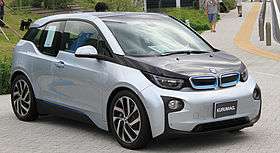



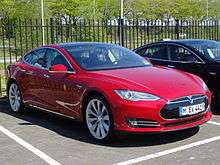
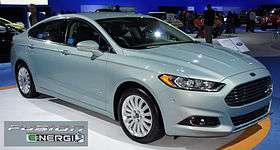
Several automobile magazines, motor vehicle specialized publications and environmental groups publish annual rankings or listings of the best green cars of a given year. The following table presents a selection of the annual top pickings.
| Selected annual rankings of green cars | |||||
|---|---|---|---|---|---|
| Vehicle | Year model | Type of vehicle/fuel | EPA Combined mileage (mpg) | EPA City mileage (mpg) | EPA Highway mileage (mpg) |
| Most efficient EPA-certified vehicles based on combined MPG rating[8][9][53][54] | |||||
| Hyundai Ioniq Electric— All years, all fuels | 2017 | Electric car | 136 mpg-e | 150 mpg-e | 122 mpg-e |
| BMW i3— All years, all fuels | 2014/16 | Electric car | 124 mpg-e | 137 mpg-e | 111 mpg-e |
| BMW i3 REx — Current year, gasoline fuel | 2014/16 | Plug-in hybrid | 88 mpg-e | 97 mpg-e | 79 mpg-e |
| Toyota Prius Eco — All years, gasoline fuel | 2016 | Hybrid electric | 56 | 58 | 53 |
| Green Car Journal — Green Car of the Year | |||||
| Chevrolet Bolt EV — 2017 Award[55] | 2017 | Electric car | 119 mpg-e | 128 mpg-e | 110 mpg-e |
| Chevrolet Volt (second generation) — 2016 Award[56][57] | 2016 | Plug-in hybrid | Gas equivalent All-electric mode | Gasoline only mode | All-electric range |
| 106 mpg-e | 42 mpg | 53 mi | |||
| BMW i3 — 2015 Award[58] | 2014 | Electric car | 124 mpg-e | 137 mpg-e | 111 mpg-e |
| Honda Accord ninth generation line-up — 2014 Award[59] | 2014 | Gasoline hybrid and plug-in variants | mim 29 mpg, hybrid 47 mpg, plug-in 115 mpg-e[60] | ||
| Ford Fusion 2nd gen line-up — 2013 Award[61] | 2013 | Gasoline, EcoBoost, hybrid and plug-in variants | mim 34 mpg, hybrid 47 mpg, plug-in 100 mpg-e | ||
| Honda Civic GX — 2012 Award[62] | 2012 | Natural gas | 28 | 24 | 36 |
| Chevrolet Volt — 2011 Award[63][64][65] | 2011 | Plug-in hybrid | Gas equivalent All-electric mode | Gasoline only mode | All-electric range |
| 93 mpg-e | 37 mpg | 35 mi | |||
| Green Car Journal — Green Car Vision Award | |||||
| Ford C-Max Energi — 2012 Award[66] | 2013 | Plug-in hybrid | Gas equivalent All-electric mode | Gasoline only mode | All-electric range |
| | | | |||
| Ford Focus Electric — 2011 Award[67] | 2012 | Electric car | Gasoline equivalent fuel economy | All-electric range | |
| 100 mi | |||||
| Nissan Leaf — 2010 Award[68][69] | 2011 | Electric car | Gasoline equivalent fuel economy | All-electric range | |
| 99 mpg-e | 73 mi | ||||
| Chevrolet Volt — 2009 Award[64][65][70] | 2011 | Plug-in hybrid | Gas equivalent All-electric mode | Gasoline only mode | All-electric range |
| 93 mpg-e | 37 mpg | 35 mi | |||
| World Car of the Year — World Green Car | |||||
| Toyota Mirai — 2016 Award[71] | 2016 | Hydrogen fuel cell | 66 mpg-e | 66 mpg-e | 66 mpg-e |
| BMW i8 — 2015 Award[72][73] | 2015 | Plug-in hybrid | Gas equivalent All-electric mode | Gasoline only mode | All-electric range |
| 76 mpg-e | 28 mpg | 15 mi | |||
| BMW i3 — 2014 Award[74] | 2014 | Electric car | Gasoline equivalent fuel economy | All-electric range | |
| 124 mpg-e | 81 mi | ||||
| Tesla Model S — 2013 Award[75] | 2013 | Electric car (60/85 kWh battery) | Gasoline equivalent fuel economy | All-electric range | |
| 95/89 mpg-e | 208/265 mi | ||||
| Mercedes-Benz S 250 CDI BlueEFFICIENCY — 2012 Award[75] | 2012 | Clean diesel | 5.7 l/100 km (50 mpg-imp; 41 mpg-US) | ||
| Chevrolet Volt — 2011 Award[76] | 2011 | Plug-in hybrid | Gas equivalent All-electric mode | Gasoline only mode | All-electric range |
| 93 mpg-e | 37 mpg | 35 mi | |||
| Volkswagen BlueMotion — 2010 Award[77] (Golf, Passat, Polo) | 2010 | Clean diesel | n.a. | n.a. | n.a. |
| Honda FCX Clarity — 2009 Award[78] (miles per kilogram of hydrogen) | 2009 | Hydrogen fuel cell | 59 mpg-e | 58 mpg-e | 60 mpg-e |
| Consumer Reports Top Picks: Green Car Category | |||||
| Tesla Model S — Best overall model 2014[79] | 2014 | Electric car (60/85 kWh battery) | Gasoline equivalent fuel economy | All-electric range | |
| 95/89 mpg-e | 208/265 mi | ||||
| Toyota Prius — Best green car 2014[79] | 2014 | Hybrid electric | 50 | 51 | 48 |
| Toyota Prius — Best green car 2013[80] | 2013 | Hybrid electric | 50 | 51 | 48 |
| Toyota Prius — Best green car 2012[81] | 2012 | Hybrid electric | 50 | 51 | 48 |
| Toyota Prius — Best green car 2011[82] | 2011 | Hybrid electric | 50 | 51 | 48 |
| Toyota Prius — Best green car 2010[83] | 2010 | Hybrid electric | 50 | 51 | 48 |
| Toyota Prius — Best green car 2009[84] | 2009 | Hybrid electric | 46 | 48 | 45 |
| Consumer Reports American Top Picks: Green Car Category | |||||
| Ford Fusion Hybrid — Top Pick 2011[85] | 2011 | Hybrid electric | 39 | 41 | 36 |
| Ford Fusion Hybrid — Top Pick 2010[86] | 2010 | Hybrid electric | 39 | 41 | 36 |
| Ford Escape Hybrid — Top Pick 2009[87] | 2009 | Hybrid electric | 32 | 34 | 31 |
| What Car? Green Awards | |||||
| BMW 320d Efficient Dynamics — Overall Winner 2012[88] | 2012 | Clean diesel | UK combined 56 mpg-imp (5.0 L/100 km; 47 mpg-US)[88] | ||
| Vauxhall Ampera — Overall Winner 2011[89] | 2012 | Plug-in hybrid | EC combined 235.4 mpg-imp (1.200 L/100 km; 196.0 mpg-US)[90] | ||
| Toyota Auris Hybrid — Overall Winner 2010[91] | 2010 | Hybrid electric | UK combined 74 mpg-imp (3.8 L/100 km; 62 mpg-US)[91] | ||
| Volvo S40 1.6D DRIVe S — Overall Winner 2009[92] | 2009 | Clean diesel | UK combined 60 mpg-imp (4.7 L/100 km; 50 mpg-US)[93] | ||
| Ford Focus 1.6 TDCi Style — Overall Winner 2008[94] | 2008 | Clean diesel | UK combined 52 mpg-imp (5.4 L/100 km; 43 mpg-US)[95] | ||
| Mother Earth News Best Green Cars | |||||
| Best Green Cars of 2011[96] | |||||
| Chevrolet Volt | 2011 | Plug-in hybrid | Gas equivalent All-electric mode | Gasoline only mode | All-electric range |
| 93 mpg-e | 37 mpg | 35 mi | |||
| Nissan Leaf | 2011 | Electric car | Gasoline equivalent fuel economy | All-electric range | |
| 99 mpg-e | 73 mi | ||||
| Toyota Prius | 2011 | Hybrid electric | 50 | 51 | 48 |
| Ford Fiesta | 2011 | Gasoline | 33 | 29 | 38 |
| Honda CR-Z CVT | 2011 | Hybrid electric | 37 | 35 | 39 |
| VW Jetta TDI | 2011 | Clean diesel | 34 | 30 | 42 |
| Best Green Cars of 2010[97] | |||||
| Ford Fusion Hybrid | 2010 | Hybrid electric | 39 | 41 | 36 |
| Honda Civic Hybrid | 2010 | Hybrid electric | 42 | 40 | 45 |
| Honda Insight | 2010 | Hybrid electric | 41 | 40 | 43 |
| Toyota Prius | 2010 | Hybrid electric | 50 | 51 | 48 |
| VW Golf TDI | 2010 | Clean diesel | 34 | 30 | 42 |
| VW Jetta TDI | 2010 | Clean diesel | 41 | 40 | 43 |
| American Council for an Energy-Efficient Economy Greenest Vehicles of the Year | |||||
| Greenest Vehicles of 2012 (Top 5)[98] | |||||
| Mitsubishi i-MiEV | 2012 | Electric car | 112 mpg-e | 3.8 mile/Kwh | 2.9 mile/Kwh |
| Honda Civic GX | 2012 | Natural gas | - | 27mpg-e | 38 mpg-e |
| Nissan Leaf | 2012 | Electric car | 99 mpg-e | 3.1 mile/Kwh | 2.7 mile/Kwh |
| Toyota Prius | 2012 | Hybrid electric | 50 | 51 | 48 |
| Honda Insight | 2012 | Hybrid electric | 42 | 41 | 44 |
| Greenest Vehicles of 2011 (Top 5)[99][100] | |||||
| Honda Civic GX | 2011 | Natural gas | 28 | 24 | 36 |
| Nissan Leaf | 2011 | Electric car | 99 mpg-e | 3.15 mile/Kwh | 2.72 mile/Kwh |
| Smart fortwo (Cabriolet/Coupe) | 2011 | Gasoline | 36 | 33 | 41 |
| Toyota Prius | 2011 | Hybrid electric | 50 | 51 | 48 |
| Honda Civic Hybrid | 2011 | Hybrid electric | 41 | 40 | 43 |
| Greenest Vehicles of 2010 (Top 5)[101] | |||||
| Honda Civic GX | 2010 | Natural gas | 28 | 24 | 36 |
| Toyota Prius | 2010 | Hybrid electric | 50 | 51 | 48 |
| Honda Civic Hybrid | 2010 | Hybrid electric | 42 | 40 | 45 |
| Smart fortwo (Convertible/coupe) | 2010 | Gasoline | 36 | 33 | 41 |
| Honda Insight | 2010 | Hybrid electric | 41 | 40 | 43 |
| Kelley Blue Book Top 10 Green Cars | |||||
| Top 10 Green Cars of 2014 (Top 5)[102] | |||||
| BMW i3 | 2014 | Electric car | Gasoline equivalent fuel economy | All-electric range | |
| 124 mpg-e | 81 mi | ||||
| Nissan Leaf | 2014 | Electric car | Gasoline equivalent fuel economy | All-electric range | |
| 99 mpg-e | 73 mi | ||||
| Toyota Prius | 2014 | Hybrid electric | 50 | 51 | 48 |
| Tesla Model S | 2014 | Electric car (60/85 kWh battery) | Gasoline equivalent fuel economy | All-electric range | |
| 95/89 mpg-e | 208/265 mi | ||||
| Honda Accord Hybrid | 2014 | Hybrid electric | 47 | 50 | 45 |
| Top 10 Green Cars of 2011 (Top 3)[103][104] | |||||
| Nissan Leaf | 2011 | Electric car | Gasoline equivalent fuel economy | All-electric range | |
| 99 mpg-e | 73 mi | ||||
| Chevrolet Volt | 2011 | Plug-in hybrid | Gasoline equivalent fuel economy | All-electric range | |
| 93 mpg-e | 35 mi | ||||
| Toyota Prius | 2011 | Hybrid electric | 50 | 51 | 48 |
| Top 10 Green Cars of 2010 (Top 3)[105][106] | |||||
| Toyota Prius | 2010 | Hybrid electric | 50 | 51 | 48 |
| Honda Insight | 2010 | Hybrid electric | 41 | 40 | 43 |
| Ford Fusion Hybrid | 2010 | Hybrid electric | 39 | 41 | 36 |
Green vehicle motor shows
Dedicated electric and green vehicle motor shows:
- Alternative Vehicle and Fuel Show (AVFS), Fair of Valladolid, Spain, in November.[107]
- Green Fleet Expo, Royal Botanical Gardens (Ontario), in May.[108]
- Green-Car-Guide Live!, Arena and Convention Centre in Liverpool, in June[109]
- European Electric Motor Show, Helsinki Exhibition & Convention Centre, in November[110][111][112]
See also
- Alternative fuel vehicle
- Alternatives to the automobile
- Better Place
- Emerging technologies - e.g. new green vehicle methods
- Green tuning
- Green Challenge
- Government incentives for plug-in electric vehicles
- Hybrid taxis
- Union of Concerned Scientists' Hybrid Scorecard
- Low-carbon emissions
- Low-carbon fuel standard
- Miles per gallon gasoline equivalent
- Motorised quadricycle
- Plug-in electric vehicles
- Progressive Insurance Automotive X Prize
- Zero emissions vehicle
Notes and references
- ↑ Millikin, Mike. "Worldwide sales of Toyota hybrids surpass 9 million units; Prius family accounts for 63%". Green Car Congress. Retrieved 2016-05-22. The Prius family accounts for 63% of Toyota's total global cumulative hybrid car sales: 5.691 million units, consisting of Prius liftback: 3.733 million; Aqua, Prius c: 1.249 million; Prius α, Prius v, Prius +: 0.634 million; Prius PHV: 75,000.
- ↑ Maynard, Micheline (2007-07-04). "Say 'Hybrid' and Many People Will Hear 'Prius'". New York Times. Retrieved 2013-07-03.
- ↑ R.I.C. Publications (2005). Rainforests. p. 67. ISBN 978-1-74126-330-5.
- 1 2 3 "Green Vehicle Guide". Green Student U. Retrieved 2010-04-24.
- ↑ Staff. "The Environmentally Friendly Car". Cheap Car Insurance. Retrieved 2016-12-03.
- ↑ Organisation for Economic Co-operation and Development, Organisation for Economic Co-operation and Development. Working Group on Low-Emission Vehicles (2004). Can cars come clean?. OECD Publishing. pp. 84–85. ISBN 978-92-64-10495-2.
- ↑ "Alternative and Advanced Vehicles". Alternative Fuels and Advanced Vehicle Data Center, U.S. Department of Energy. Retrieved 2010-04-24.
- 1 2 U. S. Environmental Protection Agency and U.S. Department of Energy (2016-11-16). "Most Efficient EPA Certified Vehicles". fueleconomy.gov. Retrieved 2016-11-19. The 2014–16 BMW i3 BEV was the most efficient EPA-certified vehicles considering all fuels and of all years until November 2016, when it was surpassed by the 2017 Hyundai Ioniq Electric. As of November 2016, the 2016 Toyota Prius Eco hybrid car is most efficient EPA-certified vehicle with a gasoline engine without plug-in capability.
- 1 2 Edelstein, Stephen (2016-11-21). "Hyundai Ioniq Electric beats Prius Prime, BMW i3 on energy efficiency". Green Car Reports. Retrieved 2016-11-21.
- 1 2 Sperling, Daniel; Deborah Gordon (2009). Two billion cars: driving toward sustainability. Oxford University Press, New York. pp. 235–260. ISBN 978-0-19-537664-7. See Chapter 9: Driving Towards Sustainability
- ↑ Strategies for Managing Impacts from Automobiles, US EPA Region 10, retrieved May 22, 2012
- ↑ "European Union's End-of-life Vehicle (ELV) Directive", End of Life Vehicles, EU, retrieved May 22, 2012
- 1 2 S&TR
- 1 2 "Consumer Reports Revises Financial Analysis In Report on Ownership Costs for Hybrid Cars". Consumer Reports. Consumers Union. 7 March 2006. Archived from the original on 2007-09-21. Retrieved 2007-04-27.
- 1 2 "The dollars & sense of hybrid cars".
- ↑ "Energy efficiency comparison article" (PDF). Retrieved 2010-12-12.
- ↑ http://shrinkthatfootprint.com/electric-car-emissions#.UWMjH5xsYH4.email|"eg India, China, Australia"
- ↑ "Alternate Fuel Technology - Battery Electric Vehicles". (245 KB)
- ↑ Precer's BioRacer Stirling engine-electric hybrid
- ↑ "Dual Fuel Cars Revive Brazil's Alcohol Industry".
- ↑ "Natural Gas Vehicle Statistics". International Association for Natural Gas Vehicles. Retrieved 2009-10-19.
- ↑ "NHTSA/DOT final rule on Neighborhood Electric Vehicles (NEV)63 FR 33913, June 17, 1998". US DEPARTMENT OF TRANSPORTATION. Retrieved 2015-11-14.
- ↑ CPSC Requirements for Low-Speed Electric Bicycles
- ↑ Search Results - THOMAS (Library of Congress)
- ↑ http://electricbikereport.com/new-california-law-electric-bike-regulations/#more-18708
- ↑ "California Assembly Bill No. 1096 CHAPTER 568 October 7, 2015.". Retrieved 2015-11-14.
- ↑ World Energy Council (2007). "Transport Technologies and Policy Scenarios". World Energy Council. Retrieved 2009-05-26.
- ↑ Weingroff, Marianne. "Activity 20 Teacher Guide: Human Activity and Climate Change". Ucar.edu. Retrieved 2010-12-12.
- ↑ "WhatGreenCar? Ratings Methodology". Whatgreencar.com. 2009-12-03. Retrieved 2010-12-12.
- ↑ Jonathan L. Ramseur (January 18, 2007). "Climate Change: Action by States To Address Greenhouse Gas Emissions" (PDF). Congressional Research Service: 16. Retrieved 2009-06-27.
- ↑ Intergovernmental Panel on Climate Change (2007). "IPCC Fourth Assessment Report: Mitigation of Climate Change, chapter 5, Transport and its Infrastructure" (PDF). Intergovernmental Panel on Climate Change. Retrieved 2009-05-26.
- ↑ "Committee on the Medical Effects of Air Pollutants (COMEAP)". Advisorybodies.doh.gov.uk. 2009-11-26. Retrieved 2010-12-12.
- ↑ Gralla, Joan (July 17, 2008). "NYC speeds transformation of yellow cabs to green". Reuters.
- ↑ CNW Marketing Research, Inc (2006). "Dust to Dust - The Energy Cost of New Vehicles From Concept to Disposal".
- ↑ Israeli company builds infrastructure for worlds electric cars
- ↑ Brendan I. Koerner, "Tank vs. Hybrid: IS IT POSSIBLE THAT A HUMMER'S BETTER FOR THE ENVIRONMENT THAN A PRIUS IS?", Slate magazine, March 18, 2008
- ↑ http://www.forbrukerombudet.no/asset/2857/1/2857_1.pdf
- ↑ Independent Newspapers Online (2010-05-05). "Prove 'clean, green' ads, Norway tells automakers". Motoring.co.za. Retrieved 2010-12-12.
- ↑ "Greenwash Watch: Norways Says Cars Neither Green Nor Clean". Treehugger.com. Retrieved 2010-12-12.
- ↑ Doyle, Alister (2007-09-06). "Norways Says Cars Neither Green Nor Clean". Reuters.com. Retrieved 2010-12-12.
- ↑ Tziovaras, T. (2011). "Is there such a thing as an environmentally-friendly car?" (PDF). World Transport Policy and Practice,17, 3: 27-31. Retrieved 2012-07-08.
- ↑ Alcott, Blake (July 2005). "Jevons' paradox". Ecological Economics. 54 (1): 9–21. doi:10.1016/j.ecolecon.2005.03.020. Retrieved 2010-08-08.
- ↑ Kunstler, James Howard (2012). Too Much Magic; Wishful Thinking, Technology, and the Fate of the Nation. Atlantic Monthly Press. ISBN 978-0-8021-9438-1.
- ↑ Gilbert, Richard (2010), "Transportation is the Post Carbon World", in McKibben, D, The Post Carbon Reader: Managing the 21st Centery Sustainability Crisis, Watershed Media, ISBN 978-0-9709500-6-2
- ↑ Black, W R (1996). "Sustainable transportation: a US perspective". Journal of Transport Geography. Elsevier. 4 (3).
- ↑ "Green cars | EU - European Information on Sustainable Dev". EurActiv.com. Retrieved 2010-12-12.
- ↑ "Growing Number of EU Countries Levying CO2 Taxes on Cars and Incentivizing Plug-ins". Green Car Congress. 2010-04-21. Retrieved 2010-04-23.
- ↑ "An Increasing Number of Member States Levy CO2-Based Taxation or Incentivise Electric Vehicles". European Automobile Manufacturers Association. 2010-04-21. Retrieved 2010-04-23.
- ↑ "Microsoft Word - GVMA Report to ORNL, March 2004.doc" (PDF). Retrieved 2010-12-12.
- ↑ "Competition Guidelines, Version 1.2, 13 January 2009" (PDF). X PRIZE Foundation. p. 5. Retrieved 2009-06-21.
- ↑ Boyle, Alan. "Auto X Prize Revs Up". MSNBC. Retrieved 2008-09-16.
- ↑ "Competition Guidelines" (PDF). progressiveautoxprize.org. Retrieved 2009-05-28.
- ↑ U. S. Environmental Protection Agency and U.S. Department of Energy (2015-12-22). "Fueleconomy.gov's Top Fuel Sippers (EPA Ratings, All Years)". fueleconomy.gov. Retrieved 2015-12-26. Excludes all-electric vehicles. Click on the tab "Top Fuel Sippers (EPA Ratings, All Years)"
- ↑ Voelcker, John (2015-12-21). "2016 Toyota Prius: Most Fuel-Efficient Car Without A Plug, Ever". Green Car Reports. Retrieved 2015-12-26. The first generation Honda Insight was the most fuel efficient gasoline-powered car available in the U.S. without plug-in capability for the length of its production run and until December 2015, when it was surpassed by the 2016 Toyota Prius Eco.
- ↑ Blanco, Sebastian (2016-11-17). "Chevy Bolt wins 2017 Green Car of the Year". Autoblog.com. Retrieved 2016-11-21.
- ↑ Blanco, Sebastian (2015-11-19). "2016 Chevy Volt wins Green Car of the Year". Autoblog Green. Retrieved 2015-11-21.
- ↑ U.S. Environmental Protection Agency and U.S. Department of Energy (2015-09-01). "Compare Side-by-Side - 2016/2015 Chevrolet Volt". Fueleconomy.gov. Retrieved 2015-09-02.
- ↑ Priddle, Alisa (2014-11-20). "BMW i3 named 2015 Green Car of the Year". Detroit Free Press. Retrieved 2014-11-21.
- ↑ Blanco, Sebastian (2013-11-21). "Honda Accord Hybrid and PHEV win 2014 Green Car of the Year". Autoblog Green. Retrieved 2013-11-23.
- ↑ Compare Side-by-Side 2014 Honda Accord variants
- ↑ Blanco, Sebastian (2012-11-29). "Ford Fusion wins 2013 Green Car Of The Year". Autoblog.com. Retrieved 2012-11-29.
- ↑ Carpenter, Susan (2011-11-17). "Honda Civic Natural Gas wins 2012 Green Car of the Year Award". Los Angeles Times. Retrieved 2011-11-17.
- ↑ "Chevrolet Volt Electric Car is 2011 Green Car of the Year". Green Car Journal. 2010-11-18. Retrieved 2010-11-18.
- 1 2 David Bailey; Kevin Krolicki (2010-11-24). "Chevy Volt tops Prius in fuel economy rating". Reuter. Retrieved 2010-11-24.
- 1 2 "Volt receives EPA ratings and label: 93 mpg-e all-electric, 37 mpg gas-only, 60 mpg-e combined". Green Car Congress. 2010-11-24. Retrieved 2010-11-24.
- ↑ Blkanco, Sebastian (2012-01-26). "Ford C-Max Energi wins 2012 Green Car Vision Award". Autoblog Green. Retrieved 2012-01-26.
- ↑ Blanco, Sebastian (2011-01-27). "DC 2011: Ford Focus Electric wins Green Car Vision award". AutoblogGreen. Retrieved 2011-01-27.
- ↑ "Nissan Leaf Electric Car Wins 2010 Green Car Vision Award". Green Car Journal. 2010-01-26. Retrieved 2010-05-09.
- ↑ Bunkley, Nick (2010-11-22). "Nissan Says Its Electric Leaf Gets Equivalent of 99 M.P.G.". New York Times. Retrieved 2010-11-23.
- ↑ "Innovative Chevy Volt Wins 2009 Green Car Vision Award". Green Car Journal. 2009-02-04. Retrieved 2010-05-09.
- ↑ "And Now There Is One… TOYOTA MIRAI Wins 2016 World Green Car Award" (Press release). New York City: PR Newswire. 2016-03-14. Retrieved 2016-03-26.
- ↑ "BMW i8 Wins 2015 World Green Car Award" (Press release). New York: World Car of the Year. 2015-04-02. Retrieved 2015-11-29.
- ↑ U.S. Environmental Protection Agency and U.S. Department of Energy (2015-08-14). "Compare Side-by-Side - 2014/2015 BMW i8". Fueleconomy.gov. Retrieved 2015-08-16.
- ↑ Henry, Jim (2014-04-17). "New York Auto Show: BMWi3 Is The 2014 World Green Car Of The Year". Forbes. Retrieved 2014-04-17.
- 1 2 PRNewswire (2013-03-28). "And Now There Is One.... Tesla Model S Declared 2013 World Green Car". International Business Times. Retrieved 2013-03-28.
- ↑ "Chevrolet Volt Declared 2011 World Green Car". World Car of the Year. 2011-04-21. Retrieved 2011-04-21.
- ↑ "World Green Car: 2010". World Car of the Year. Retrieved 2010-05-02.
- ↑ "World Green Car: 2009 Eligible Vehicles". World Car of the Year. Retrieved 2010-05-02.
- 1 2 "Consumer Reports' Top Picks 2014 - The best models in 10 categories". Consumer Reports. February 2014. Retrieved 2014-04-21.
- ↑ "Top Picks 2013 Best car models of the year in 10 categories". Consumer Reports. April 2013. Retrieved 2014-04-21.
- ↑ "2012 Annual Auto Issue: Consumer Reports names its 2012 Top Picks". Consumer Reports. 2012-02-28. Retrieved 2014-04-21.
- ↑ "Top Picks: Best models of the year in 10 categories". Consumer Reports. 2011-02-28. Retrieved 2012-02-08.
- ↑ "Top Picks: Best models of the year in 10 categories - Green Car". Consumer Reports. April 2010. Retrieved 2010-05-09.
- ↑ "Consumer Reports Top Picks 2009". Consumer Reports. 2009-02-27. Retrieved 2010-05-09.
- ↑ "Consumer Reports American Top Picks 2011". Consumer Reports. 2011-03-03. Retrieved 2012-02-08.
- ↑ "Consumer Reports American Top Picks 2010". Consumer Reports. 2010-02-26. Retrieved 2010-05-02.
- ↑ "Consumer Reports American Top Picks 2009". Consumer Reports. 2009-03-04. Retrieved 2010-05-09.
- 1 2 Hallett, Chas (2012-09-19). "BMW 320d ED wins Green Car of the Year". What Car?. Retrieved 2012-09-27.
- ↑ "What Car? Green Awards 2011 - Overall Winner". What Car?. 2011-09-07. Retrieved 2012-02-08.
- ↑ "Vauxhall Ampera is urban fuel champion". Which?. 2012-01-23. Retrieved 2012-02-08.
- 1 2 "What Car? Green Awards 2010 - And the 2010 Award winner is...". What Car?. 2010-07-01. Retrieved 2010-07-01.
- ↑ "What Car? Green Awards 2009 - Overall winner". What Car?. 2009-06-04. Retrieved 2010-05-09.
- ↑ "Volvo S40 Tech Spec (UK)". Volvocars.com. 2010-05-26. Retrieved 2010-12-12.
- ↑ "What Car? Green awards 2008 - Winner". What Car?. 2008-07-22. Retrieved 2010-05-02.
- ↑ "Ford Focus 1.6 TDCi Style 5dr 110 Diesel Estate (UK)". Buyacar.co.uk. 2008-01-01. Retrieved 2010-12-12.
- ↑ "Best Green Cars, 2011". Mother Earth News. May 2011. Retrieved 2012-02-08. June–July 2011 issue
- ↑ "2010 Best Green Cars". Mother Earth News. March 2010. Retrieved 2010-05-02. April–May 2010 issue
- ↑ American Council for an Energy-Efficient Economy (2011-02-08). "Greenest Vehicles of 2012". GreenCars.org. Retrieved 2011-02-08.
- ↑ American Council for an Energy-Efficient Economy (2011-02-15). "Greenest Vehicles of 2011". GreenCars.org. Retrieved 2011-02-15.
- ↑ John O'Dell (2011-02-17). "Chevy Volt Slips to 13th Place in Revised ACEEE Green Car Rankings". Edmunds.com Green Car Adviser. Retrieved 2011-02-17.
- ↑ "Hybrids Dominate 2010 List of Greenest Vehicles". HybridCars.com. 2010-01-19. Retrieved 2010-09-26.
- ↑ Loveday, Eric (2014-04-21). "BMW i3 Named Kelley Blue Book's Best Green Car Of 2014". InsideEvs.com. Retrieved 2014-04-21.
- ↑ Koch, Wendy (2011-04-12). "Greenest cars? Gas prices drive interest in fuel economy". USA Today. Retrieved 2011-04-15.
- ↑ "Top 10 Green Cars for 2011". Kelley Blue Book. 2011-04-12. Retrieved 2011-04-15.
- ↑ "KBB Green: Top 10 Green Cars for 2010". Kelley Blue Book. April 2010. Retrieved 2010-05-02.
- ↑ "KBB's green cars list includes VW Golf TDI, Chevy Tahoe hybrid". USA Today. 2010-04-20. Retrieved 2010-05-02.
- ↑ "Alternative Vehicle and Fuel Show 2010". Feriavalladolid.com. Retrieved 2010-12-12.
- ↑ "City of Toronto: Fleet Services - Green Fleet Expo". Toronto.ca. 2000-10-23. Retrieved 2010-12-12.
- ↑ "Green-Car-Guide Live! 2008, the UK's largest Green Motor Show". Green-car-guide.com. 2008-06-12. Retrieved 2010-12-12.
- ↑ Archived July 21, 2009, at the Wayback Machine.
- ↑ Added by Antti View Events. "Electric Motor Show in Helsinki on 6–8 November 2009 - Electric A!D". Electricaid.ning.com. Retrieved 2010-12-12.
- ↑ Yoney, Domenick (2009-10-13). "eCorolla to debut at Finnish Electric Motor Show [w/VIDEO] — Autoblog Green". Green.autoblog.com. Retrieved 2010-12-12.
Further reading
- Leitman, Seth; Brant, Bob (October 2008). Build Your Own Electric Vehicle, 2nd Edition. McGraw-Hill, Inc. ISBN 0-07-154373-2.
- Tobin Smith; Jim Woods; Liz Claman (2008). "Waving the Green Flag, Clean Transportation". Billion Dollar Green. John Wiley and Sons. pp. 35–46. ISBN 978-0-470-34377-7.
- DFE2008 Automobile Engines, Wikiversity
External links
| Wikinews has news related to: |
- 2013 VehicleTechnologies Market Report, Oak Ridge National Laboratory
- Alternative Fuels and Advanced Vehicle Data Center
- AU Green Vehicle Guide
- Clean Car Calculator (Institute for Energy Efficiency)
- Clean Cities - 2014 Vehicle Buyer's Guide, National Renewable Energy Laboratory (NREL), U.S. Department of Energy, Clean Cities program. December 2013.
- Cradle-to-Grave Lifecycle Analysis of U.S. Light-Duty Vehicle-Fuel Pathways: A Greenhouse Gas Emissions and Economic Assessment of Current (2015) and Future (2025-2030) Technologies (includes estimated cost of avoided GHG emissions from different AFV technologies), Argonne National Laboratory, June 2016.
- Earth cars
- EPA Green Vehicle Guide
- Green Cars (Autocar)
- Green Car Center (Yahoo)
- Green Car Guide.
- Infographic: Green Cars 101 (2011)
- Green cars and eco driving
- Green Progress
- Model Year 2014 Fuel Economy Guide , U.S. Environmental Protection Agency and U.S. Department of Energy, April 2014.
- Progressive Insurance Automotive X PRIZE homepage
- Small Efficient Vehicles Wiki: People's Car Project
- State of Charge: Electric Vehicles’ Global Warming Emissions and Fuel-Cost Savings across the United States (UCS)
- Top Ten EPA-Rated Fuel Sippers (2016) - including BEVs and PHEVs
- UCS Hybrid Scorecard (Union of Concerned Scientists)



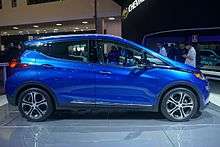


_(2).jpg)
